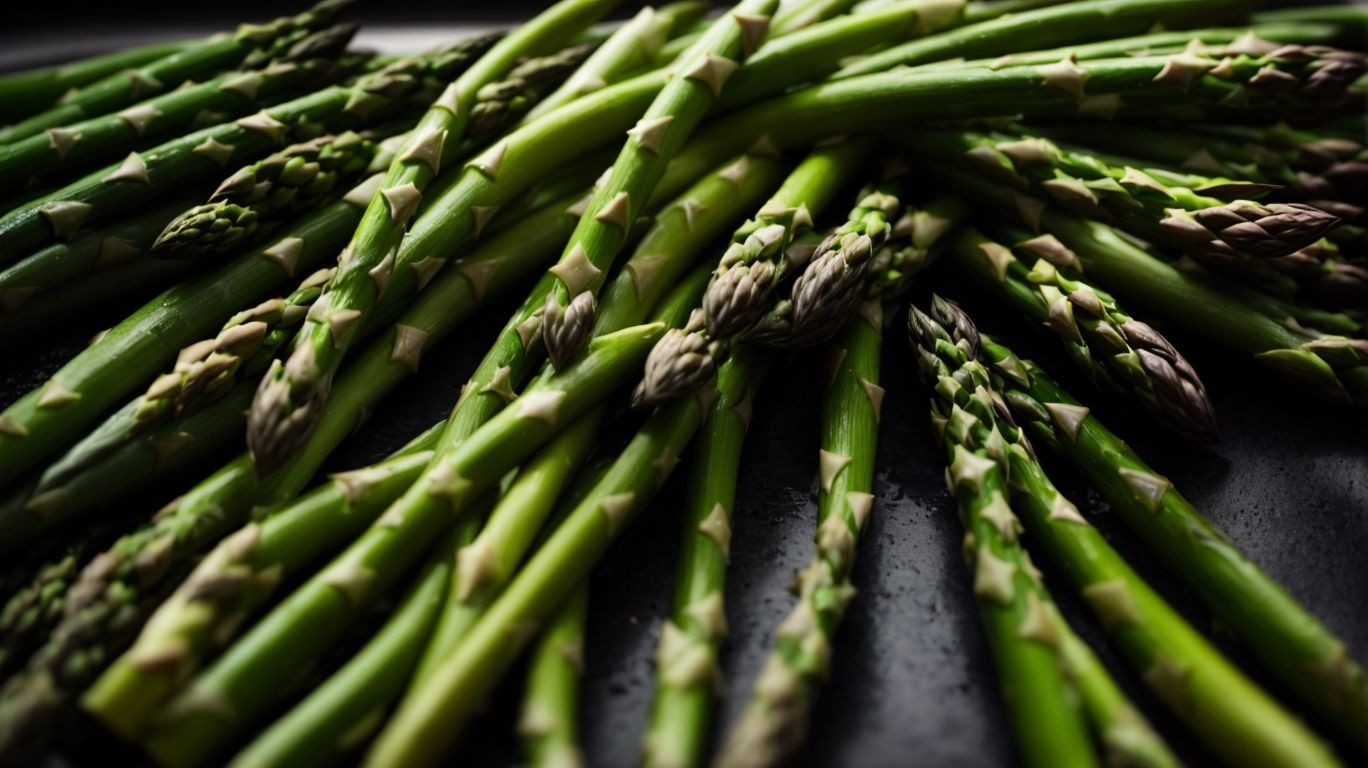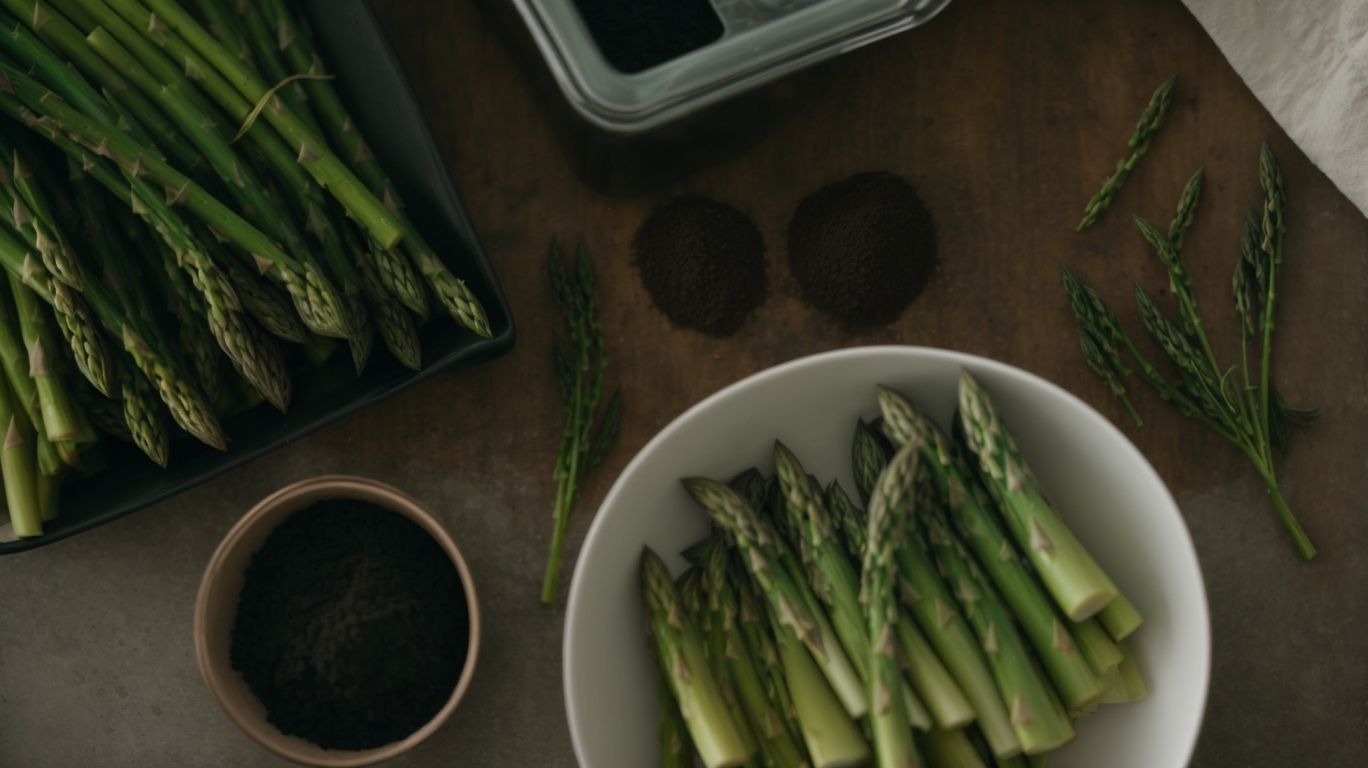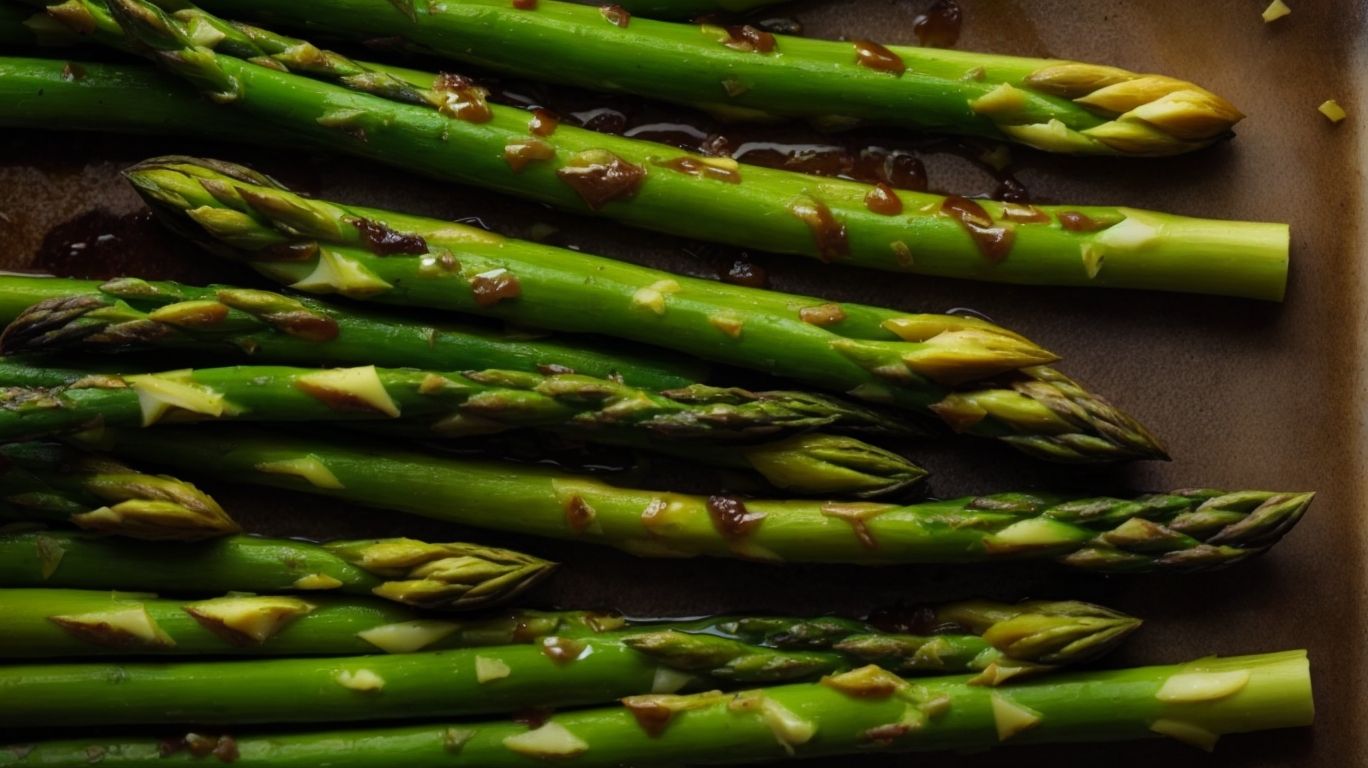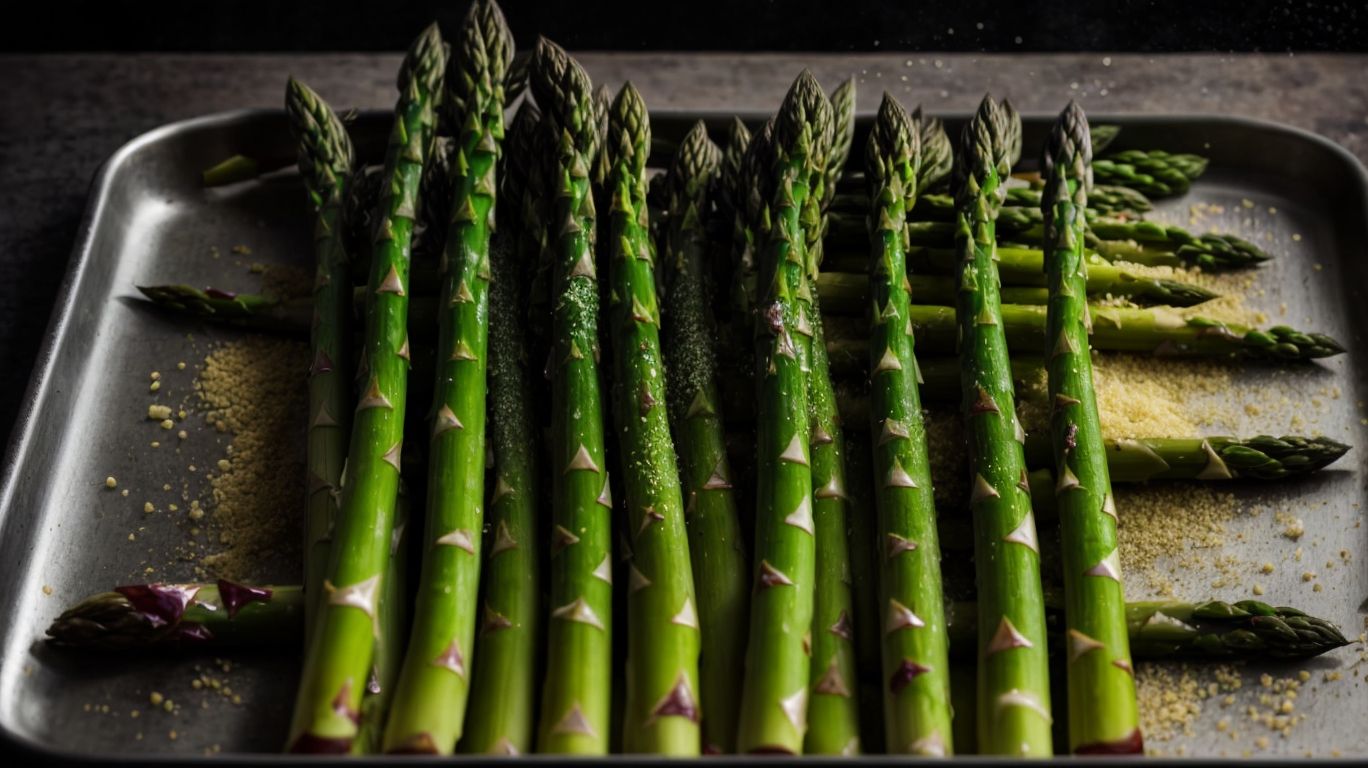How to Bake Asparagus?
Looking for a simple and delicious way to enjoy asparagus? Baking asparagus is a great option that retains nutrients, is easy to prepare, and offers versatility in flavors.
We will discuss why baking asparagus is a fantastic choice and provide step-by-step instructions on how to bake it perfectly. We will also cover how to tell when asparagus is done, serving suggestions, and tips for achieving perfectly baked asparagus every time.
Start your culinary journey with this flavorful vegetable!
Key Takeaways:
Why Bake Asparagus?

Credits: Poormet.Com – Jose Carter
Baking asparagus is not only a delicious way to enjoy this versatile vegetable but also a method that helps retain essential nutrients crucial for your well-being.
When you bake asparagus, the heat helps to lock in the nutrients that might otherwise be lost during other cooking methods. Asparagus is a rich source of vitamins K, C, and A, as well as folate, fiber, and antioxidants, which are essential for maintaining good overall health.
Baking enhances the natural flavors of asparagus, creating a caramelized exterior while maintaining a tender interior. This cooking technique brings out the sweetness of the vegetable and adds a depth of flavor that might be missing with other methods.
Choosing to bake asparagus over other cooking methods is a popular choice among home cooks due to its simplicity and ability to create a dish that is both nutritious and delicious. The low calorie and low sodium content of asparagus make it a wonderful addition to any balanced diet, contributing to weight management and heart health.
Retains Nutrients
Baking asparagus is a superior cooking method as it helps retain the vital nutrients, vitamins, and minerals present in this green vegetable.
When asparagus is baked, the gentle heat helps to preserve the delicate structure of nutrients like vitamin C and folate, which can be easily destroyed by higher cooking temperatures. Compared to boiling or steaming, which can cause water-soluble vitamins to leach out, baking ensures that these essential nutrients stay locked in the stalks. Minerals such as potassium and fiber in asparagus are not depleted as much through baking, maintaining their nutritional value.
Easy to Prepare
Preparing baked asparagus is a straightforward and hassle-free process that requires minimal effort and time, making it an ideal side dish for any meal.
To start, begin by preheating your oven to 425°F (220°C) and lining a baking sheet with parchment paper for easy cleanup.
Next, wash the asparagus spears under cold water and trim off the tough ends. This step is crucial for ensuring that the asparagus cooks evenly and is tender.
Once the asparagus is prepped, arrange the spears in a single layer on the baking sheet. Drizzle olive oil over the asparagus, ensuring that each spear is evenly coated. You can also season the asparagus with a pinch of salt and pepper for added flavor.
Place the baking sheet in the oven and bake the asparagus for around 12-15 minutes, or until the spears are tender and slightly caramelized. Avoid overcooking the asparagus, as it can become mushy and lose its vibrant color and nutrients.
Versatile for Different Flavors
Baked asparagus offers a versatile canvas for exploring various flavors and seasonings, allowing you to customize this dish to suit your taste preferences.
In terms of seasoning baked asparagus, the possibilities are endless. For a classic option, try sprinkling garlic powder, lemon zest, and a touch of olive oil before roasting. This imparts a refreshing and zesty flavor profile to the dish. If you prefer a more robust taste, consider tossing your asparagus spears with balsamic vinegar, parmesan cheese, and a pinch of black pepper for a savory kick.
For those looking to experiment, venture into the realm of exotic flavors by incorporating toasted sesame oil, soy sauce, and a sprinkle of sesame seeds in your seasoning mix. This Asian-inspired twist adds depth and umami notes to the asparagus. Don’t be afraid to mix and match different herbs and spices like rosemary, thyme, paprika, or even curry powder to create unique and tantalizing combinations.
What You’ll Need to Bake Asparagus

Credits: Poormet.Com – Ronald Harris
To bake delicious asparagus, you’ll need fresh asparagus spears, olive oil for roasting, a sprinkle of salt and pepper for seasoning, and optional ingredients like garlic and Parmesan cheese for added flavor.
When preparing roasted asparagus, the key is starting with fresh asparagus spears to ensure they retain their natural crunch and vibrant green color after baking. The olive oil not only helps to cook the asparagus evenly but also imparts a delightful richness and depth of flavor. A simple sprinkle of salt and pepper enhances the natural taste of the asparagus without overpowering it. For those looking to elevate the dish, adding minced garlic lends a fragrant aroma and a hint of sweetness, while Parmesan cheese offers a creamy, umami finish.
Fresh Asparagus
Fresh asparagus is the key ingredient for a successful baked asparagus dish, ensuring a vibrant color, crisp texture, and optimal flavor in every bite.
When selecting asparagus spears for baking, opt for firm stalks with closed, compact tips and a vibrant green or slightly purple hue. Avoid wilted or dry ends as they indicate age. Fresh asparagus not only enhances the visual appeal of your dish with its bright color but also contributes to a more pronounced flavor profile, adding a refreshing crunchiness.
To preserve the freshness of your asparagus, store it upright in a glass of water or wrap the ends in a damp paper towel and place them in the refrigerator. This helps maintain their crispness and flavor for longer periods.
Olive Oil
Olive oil serves as the primary cooking oil for roasting asparagus, imparting a delicate flavor and helping to achieve a crispy exterior while retaining the vegetable’s natural moisture.
In terms of choosing the right olive oil for roasting asparagus, opting for extra virgin olive oil is preferred due to its rich flavor profile and high smoke point, which allows for a successful roasting process without burning the oil. This type of olive oil not only enhances the taste of the asparagus but also offers numerous health benefits, being rich in antioxidants and monounsaturated fats.
To use olive oil effectively in baked asparagus recipes, drizzle it evenly over the spears before seasoning with salt, pepper, and any additional herbs or spices. Ensure that the asparagus is spread out in a single layer on the baking sheet to allow for even cooking and optimal crispiness.
Salt and Pepper
A simple yet essential combination, salt and pepper are the classic seasonings that elevate the flavors of roasted asparagus, adding a perfect balance of savoriness and warmth.
When roasting asparagus, the salt works to enhance the natural earthy sweetness of the vegetable while reducing any bitterness that might be present. Meanwhile, the pepper adds a subtle kick of heat, creating a harmonious contrast against the mildness of the asparagus. These two seasonings not only season the asparagus but also bring out its inherent flavors, making each bite a delightful experience.
- To master the art of seasoning asparagus, try sprinkling salt and pepper generously over the spears just before roasting.
- For a twist, experiment with flavored salts or pepper blends to add depth and complexity to the dish.
- Remember, the key is to taste as you season, adjusting the amounts based on personal preference.
Optional Flavorings (Garlic, Lemon, Parmesan)
For those looking to add extra flair to their baked asparagus, optional flavorings like garlic for a savory kick, lemon for a zesty twist, and Parmesan for a cheesy finish can take this dish to the next level.
If you want to elevate the taste profile of your roasted asparagus, consider infusing minced garlic with olive oil before drizzling it over the spears. The combination of the earthy garlic flavor with the tender asparagus creates a delightful blend that tantalizes the taste buds.
Alternatively, a squeeze of fresh lemon juice can brighten up the dish with its citrusy notes, adding a refreshing contrast to the roasted flavors. Sprinkle some grated Parmesan cheese on top just before serving to create a decadent umami-rich experience that will please even the most discerning palate.
Step-by-Step Instructions for Baking Asparagus
Mastering the art of baking asparagus is a straightforward process that involves preheating the oven, preparing the asparagus spears, seasoning them to perfection, and baking until tender and slightly crispy.
To begin, preheat the oven to 400°F to ensure that the asparagus cooks evenly. Meanwhile, wash the spears under cold water and trim off the tough ends. For added flavor, consider drizzling them with olive oil and sprinkling salt, pepper, and garlic powder.
Arrange the seasoned asparagus on a baking sheet in a single layer, ensuring they are not overcrowded. This allows for proper caramelization and a delightful crunch. Roast in the preheated oven for around 12-15 minutes, depending on your desired level of doneness.
When ready, the asparagus should be tender with crispy tips. Avoid overcooking to maintain a vibrant green color and a satisfying texture. Serve hot as a delicious side dish or combine with other ingredients for a more elaborate meal.
Preheat the Oven
The first step in baking asparagus is to preheat the oven to the recommended temperature, ensuring that the vegetable cooks evenly and acquires a delightful roasted flavor.
In terms of roasting asparagus, selecting the right temperature is key. For tender spears with a slight crispness, a moderate heat of around 400°F (200°C) works well. This temperature allows the asparagus to cook through without becoming mushy or losing its vibrant green color.
For a quicker, more intense roast, you can crank up the heat to around 425°F (220°C). This higher temperature will result in slightly charred tips and a more pronounced flavor.
Regardless of the temperature choice, remember to preheat the oven for at least 10-15 minutes. Preheating ensures that the oven reaches the desired temperature consistently, setting the stage for perfectly roasted asparagus every time.
Prepare the Asparagus
Before baking, it’s essential to prepare the asparagus by trimming the tough ends and arranging the spears on a baking sheet, ready to absorb the flavors and heat of the oven.
-
When trimming the asparagus, ensure to snap off the woody ends by bending each spear gently until it naturally breaks at the point where the tough portion meets the tender part. This method guarantees that you remove the inedible parts while keeping the flavorful and tender sections intact.
-
After trimming, give the asparagus a thorough wash under cold running water to remove any dirt or impurities. Pat them dry with a kitchen towel to prevent excessive moisture during roasting, which can result in steaming rather than roasting.
-
When arranging the spears on the baking sheet, make sure to lay them in a single layer to allow even cooking and caramelization. Drizzle with olive oil, sprinkle with salt and pepper, or add your favorite seasonings to enhance the flavor profile.
Season the Asparagus
Seasoning the asparagus is a crucial step in enhancing its taste, with options ranging from simple salt and pepper to more adventurous choices like garlic, lemon zest, or Parmesan cheese.
When seasoning asparagus for roasting, it is important to ensure that the flavors complement rather than overpower the natural taste of the vegetable. Some classic combinations include olive oil, minced garlic, and a sprinkle of sea salt for a robust flavor. Alternatively, a drizzle of balsamic glaze can add a touch of sweetness, while a sprinkle of smoked paprika brings a smoky depth to the dish. Experimenting with different herbs like rosemary or thyme can also provide an aromatic dimension to the roasted asparagus.
Bake the Asparagus
Once seasoned to perfection, the asparagus is ready to be baked in the oven, where it transforms into a delectable dish with a tender interior and slightly crispy exterior.
Baking asparagus is a simple yet rewarding process. To achieve the perfect texture, preheat oven to 400°F (200°C). Spread the seasoned asparagus spears in a single layer on a baking sheet lined with parchment paper, ensuring they have enough space for even cooking.
Cook for around 12-15 minutes, but remember to check on them periodically. To test for doneness, pierce a spear with a fork; it should be tender but still slightly firm. Be cautious not to overcook, as asparagus can quickly turn mushy.
Once done, remove from the oven and serve immediately for optimal taste and texture. Enjoy this nutritious and flavorsome side dish!”
How to Tell When Asparagus is Done?
Determining the doneness of asparagus is a matter of assessing its texture and color, aiming for a tender yet slightly crisp consistency that indicates the vegetable is perfectly roasted and ready to be enjoyed.
One of the key visual cues to look for is a vibrant green color that turns a brighter shade. As asparagus cooks, the stalks transition from a dull green to a brighter hue, signaling that they are reaching the ideal level of doneness. You can gently pierce the asparagus with a fork or knife to check for tenderness. The stalk should offer some resistance but still yield to pressure, indicating that it is cooked just right.
Serving Suggestions for Baked Asparagus
Baked asparagus is a versatile dish that can be served in various ways, such as a delightful side dish, a refreshing addition to salads, or a flavorful topping for pasta or pizza.
For a light and healthy option, consider wrapping the baked asparagus in prosciutto or bacon before roasting to add a savory twist. You can also drizzle balsamic glaze over the spears for a sweet and tangy flavor profile that beautifully complements the earthy taste of asparagus.
To elevate the visual appeal of your dish, arrange the baked asparagus spears in a crisscross pattern on the plate or stack them neatly for a more artistic presentation. Adding a sprinkle of toasted almonds or shaved Parmesan cheese on top can provide a delightful crunch and an extra layer of richness to your creation.
As a Side Dish
As a versatile side dish, baked asparagus pairs well with a variety of main courses, offering a nutritious and flavorful addition to your meals.
When serving baked asparagus, consider incorporating lemon zest and Parmesan cheese for a zesty twist, or sprinkle some toasted almonds on top for added crunch. The portion size for asparagus as a side dish typically ranges from 4-6 spears per person, depending on the rest of the meal components.
For protein pairings, try serving roasted asparagus alongside
- grilled salmon
- roasted chicken
- pan-seared tofu
to create a well-rounded dish. Complementing it with
- quinoa
- wild rice
- couscous
can enhance the overall texture and flavor profile. To elevate the dish further, drizzle some balsamic glaze or creamy hollandaise sauce for a gourmet touch.
In Salads
Roasted asparagus makes a vibrant and nutritious addition to salads, bringing a burst of flavor, color, and texture to your favorite leafy greens and vegetables.
When incorporating roasted asparagus into salads, consider pairing it with ingredients that complement its earthy and slightly sweet undertones. For a simple yet delicious salad, combine roasted asparagus with cherry tomatoes, feta cheese, and a balsamic vinaigrette dressing. The tanginess of the feta and the acidity of the balsamic perfectly balance the richness of the asparagus.
For a more substantial salad, add quinoa, roasted red peppers, and a lemon herb dressing to the roasted asparagus. The nuttiness of the quinoa, the sweetness of the peppers, and the freshness of the lemon herb dressing create a harmonious blend of flavors and textures.
As a Topping for Pasta or Pizza
Transform your pasta or pizza dishes with the addition of roasted asparagus as a flavorful topping, adding a unique twist and vibrant taste to your favorite Italian-inspired meals.
Roasted asparagus offers a delightful contrast of textures and flavors to creamy pasta dishes like fettuccine Alfredo or carbonara. Its earthy notes complement the richness of the sauce, creating a harmonious balance. For pizza lovers, consider pairing roasted asparagus with tangy goat cheese and caramelized onions on a thin crust for a gourmet experience. The slight crunch of the asparagus against the gooey cheese and sweet onions is a true delight for the taste buds.
When roasting asparagus specifically for pasta or pizza, drizzle olive oil, sprinkle salt, and roast at high heat until tender but still slightly crisp. This will intensify its flavor and retain its nutrients, ensuring a delectable addition to your dish.
Tips for Perfectly Baked Asparagus

Credits: Poormet.Com – Adam Scott
Achieving perfectly baked asparagus requires attention to detail and a few handy tips, such as choosing fresh spears, using high heat for roasting, avoiding overcrowding the baking sheet, and experimenting with different flavor combinations.
When selecting asparagus, look for firm stalks with tight tips, as these are indicators of freshness and tenderness. Before roasting, remember to trim the tough ends of the spears, which can be tough and fibrous. Asparagus reacts well to olive oil, garlic, lemon zest, parmesan, or balsamic glaze for added flavor profiles. To prevent sogginess, ensure the spears are dry before tossing them in oil and seasonings. During roasting, shake the pan occasionally to promote even browning and crispy texture.
Choose Fresh Asparagus
Selecting fresh and vibrant asparagus is essential for ensuring a flavorful and visually appealing roasted dish, so opt for spears that are firm, brightly colored, and free from blemishes.
When choosing asparagus, look for spears that have tightly closed tips, a sign of freshness and tenderness. Run your fingers along the stalks to feel for firmness and ensure they are not limp or bend easily. The color should be uniform and vibrant green without any yellowing, indicating peak ripeness. Avoid any spears that appear shriveled or slimy, as these are likely past their prime.
For storage, wrap the bottom of the asparagus bunch in a damp paper towel and place it in a plastic bag in the refrigerator. This helps maintain moisture and freshness for a few days. Before roasting, trim the woody ends by bending the spear until it snaps naturally, removing any fibrous portions that can hinder the cooking process. Whether you choose to roast them whole or cut them into bite-sized pieces, a drizzle of olive oil, a sprinkle of salt, and a dash of pepper can elevate the flavors during roasting. By following these selection, storage, and preparation tips, you can enjoy roasted asparagus at its peak deliciousness.
Use High Heat
Baking asparagus at high heat is key to achieving a caramelized exterior and tender interior, imparting a depth of flavor and texture that elevates the overall taste of the dish.
When asparagus is exposed to high temperatures in the oven, the natural sugars in the vegetable caramelize, creating a sweet and slightly charred taste that adds complexity to each bite. This caramelization process not only enhances the flavor but also results in a visually appealing presentation with beautifully browned edges.
To maximize the caramelization effect, preheat your oven to around 425°F (218°C) or higher. The high heat will quickly sear the asparagus, locking in its natural juices and flavors while maintaining a crisp texture.
Don’t Overcrowd the Baking Sheet
To ensure even cooking and crispy results, avoid overcrowding the baking sheet when roasting asparagus, allowing enough space between the spears for proper air circulation and caramelization.
When arranging vegetables for roasting, it’s crucial to space them out properly to optimize the cooking process. By ensuring the spears are not touching each other on the baking sheet, you allow the hot air in the oven to circulate around each piece evenly. This promotes uniform cooking and browning, resulting in a deliciously caramelized exterior.
To maximize surface contact and enhance the flavors, lay the asparagus in a single layer without overlap. This way, each spear gets direct exposure to the heat, leading to a perfect texture and flavor profile. Remember, overcrowding can lead to steaming instead of roasting, affecting the desired crispy outcome. Hence, give each spear its space and let the oven work its magic for a delectable dish.
Experiment with Different Flavor Combinations
Embrace culinary creativity by experimenting with diverse flavor combinations and seasonings when roasting asparagus, from tangy lemon zest to aromatic garlic, to discover unique and delicious taste profiles.
For a fresh and citrusy twist, consider adding a sprinkle of sumac or a drizzle of lemon-infused olive oil before roasting your asparagus. The zesty flavors will brighten up the dish and complement the earthiness of the vegetable.
If you prefer a more robust taste, try dusting your asparagus spears with smoked paprika or chipotle seasoning for a hint of smokiness that pairs beautifully with the natural sweetness of the asparagus.
Frequently Asked Questions
What are the benefits of baking asparagus?
Baking asparagus is a healthy cooking method that preserves its nutrients, including vitamins A, C, and K, folate, and fiber. It also brings out a unique flavor and texture that make this vegetable a delicious side dish or main course.
What is the ideal temperature for baking asparagus?
The ideal temperature for baking asparagus is 400 degrees Fahrenheit. This temperature allows the asparagus to cook evenly and develop a crispy texture on the outside while remaining tender on the inside.
How long does it take to bake asparagus?
On average, it takes about 15-20 minutes to bake asparagus. However, the cooking time may vary depending on the thickness of the asparagus spears and personal preference. Thicker spears may take longer to cook, while thinner ones may be ready in less time.
Do I need to preheat the oven before baking asparagus?
Yes, it is essential to preheat the oven before baking asparagus. This allows for even cooking and helps the asparagus to develop a crispy texture on the outside while remaining tender on the inside.
Can I add seasoning or herbs to baked asparagus?
Absolutely! Adding seasoning or herbs to baked asparagus can enhance its flavor. Some popular options include garlic powder, lemon pepper, and fresh herbs like thyme or rosemary. Experiment with different seasonings to find your favorite combination.
What is the best way to store leftover baked asparagus?
If you have any leftover baked asparagus, let it cool completely before storing it in an airtight container in the refrigerator. It should stay fresh for up to 3-4 days. To reheat, simply place it in the oven at 350 degrees Fahrenheit for 5-10 minutes or until heated through.

